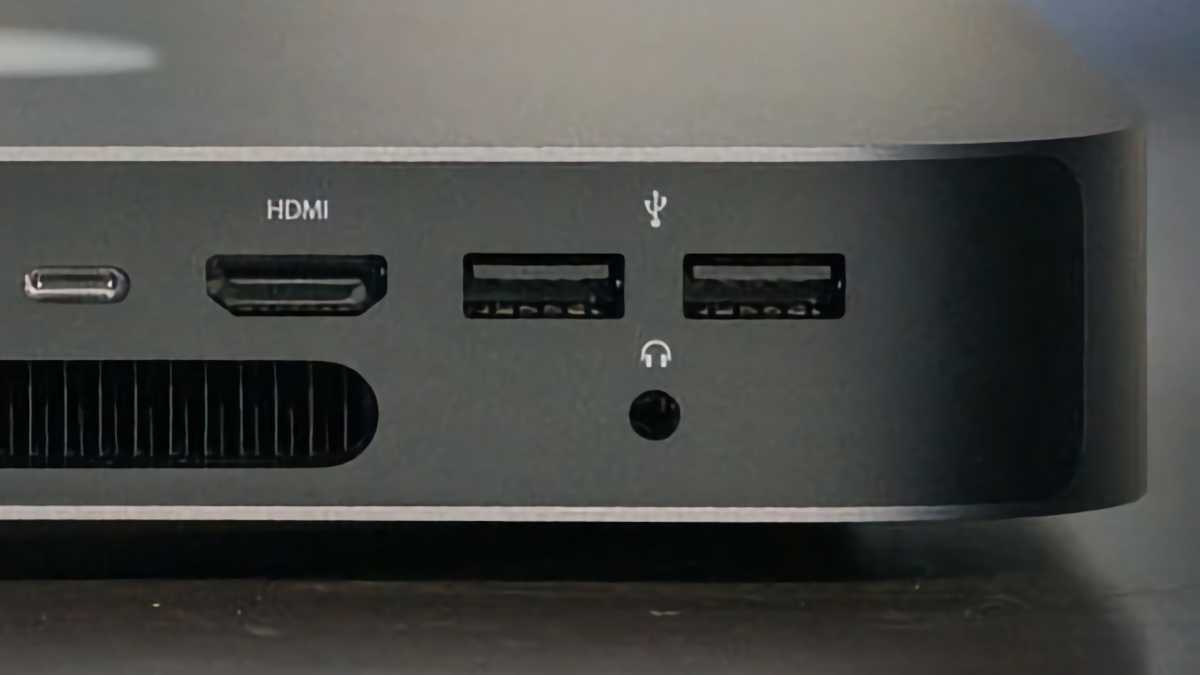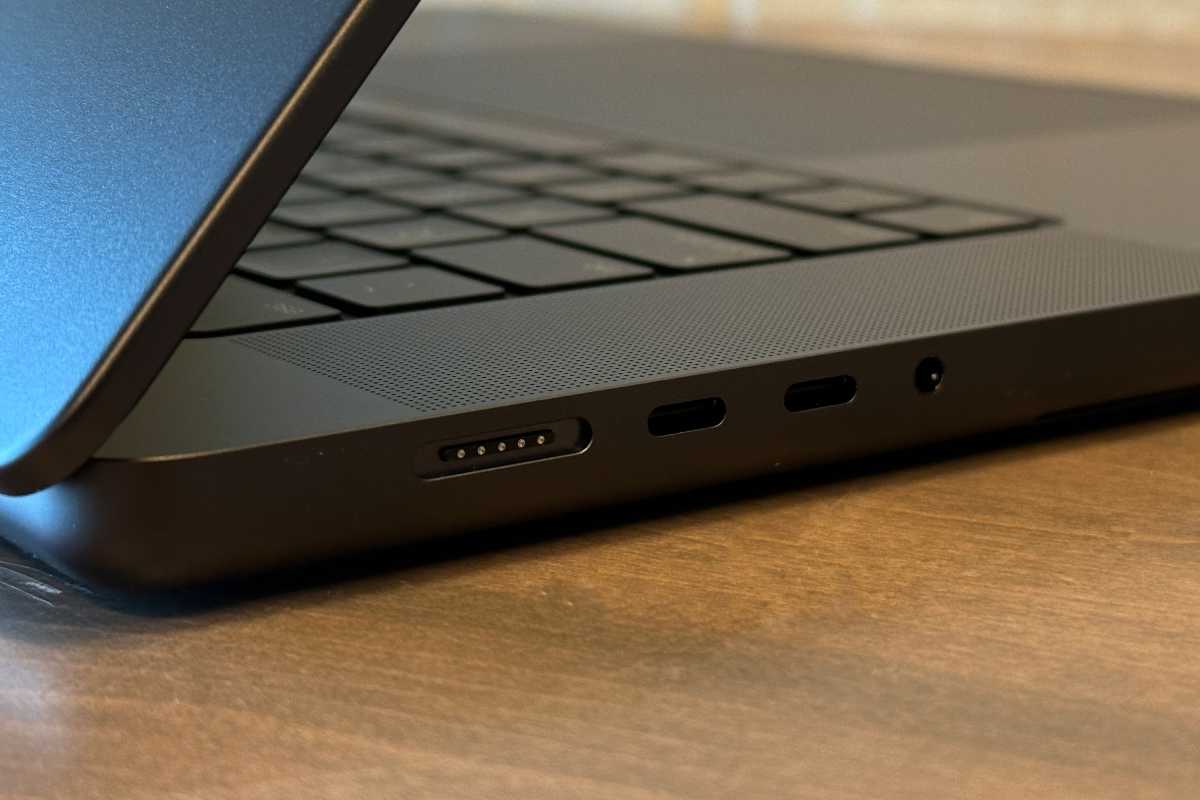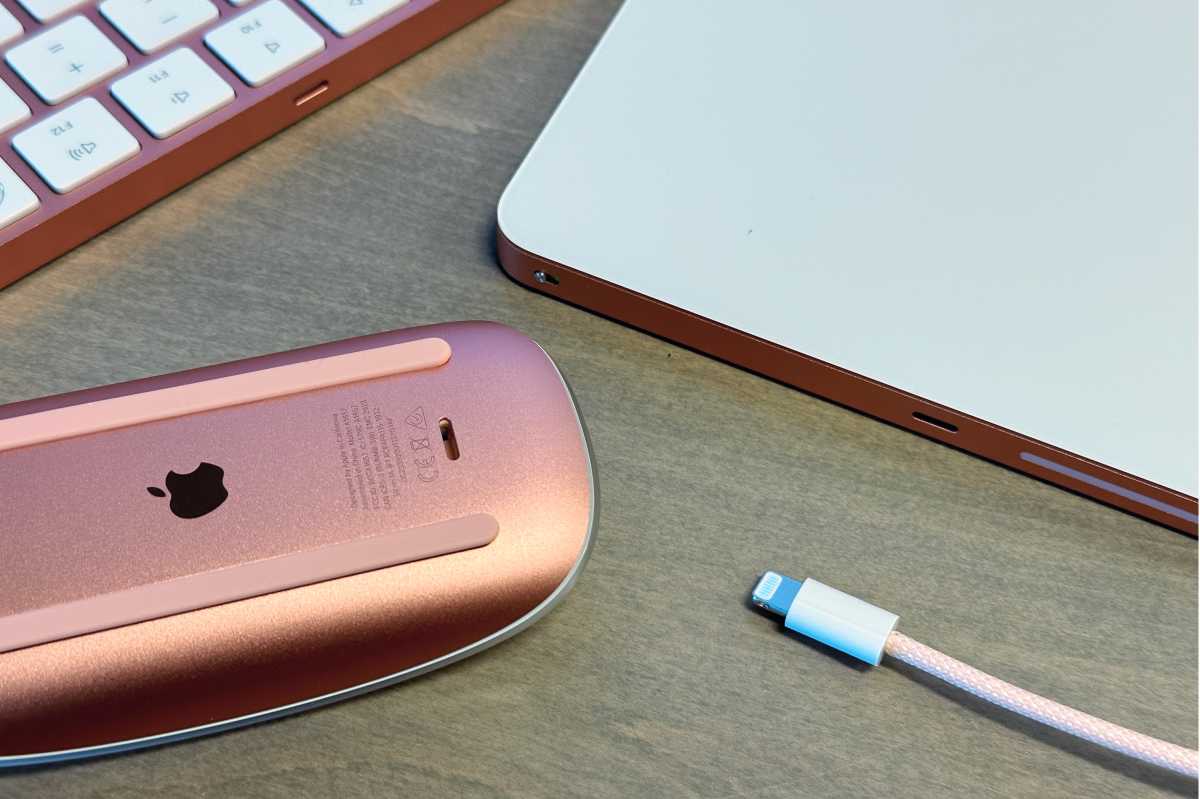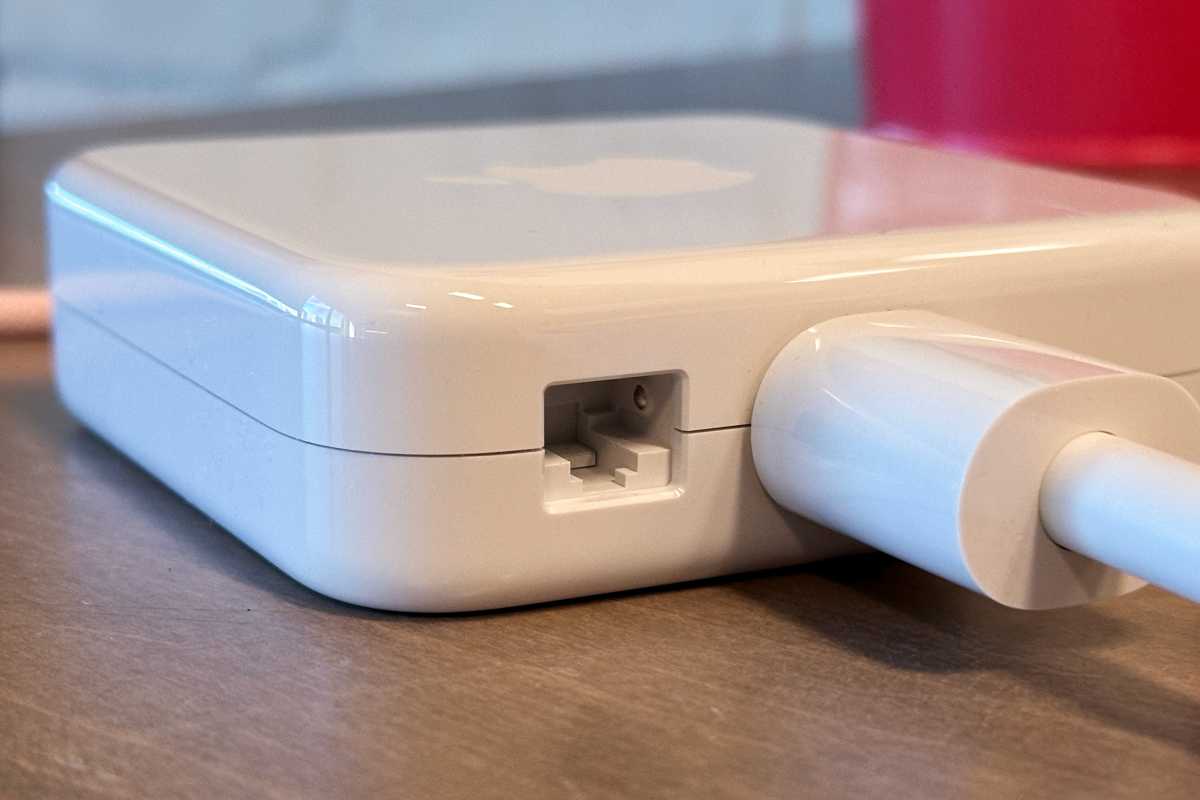Apple devices come with a range of ports into which you plug accessories, chargers, and other external devices. But, with technology constantly changing and bringing new hardware solutions to old problems, how can you keep up with the current openings on your Apple devices?
From HDMI to USB-C and everything in-between, here’s our quick reference guide. The first section lists the ports on each major Apple device. The second section explains what each port does and what it’s used for.
iPhone ports
In 2023, Apple introduced the iPhone 15 lineup that replaced the Lightning port with USB-C. Going forward, USB-C will be the port in all new iPhones. Here is the port configuration for the iPhones Apple currently sells:
| Model | USB-C | Lightning | MagSafe |
|---|---|---|---|
| iPhone 15 Pro and Pro Max | • (USB 3) | • | |
| iPhone 15 | • (USB 2) | • | |
| iPhone 14 | • | • | |
| iPhone 13 | • | • | |
| iPhone SE | • |
MacBook ports
Apple currently offers two different MacBook models, the MacBook Air, and the MacBook Pro. Apple offers different port configurations for each model and size. Here’s a look at what each laptop has:
| Model | Thunderbolt/USB 4 | MagSafe 3 | SDXC | HDMI 2.1 | 3.5mm headphone jack |
|---|---|---|---|---|---|
| 13? MacBook Air | 2 | • | • | ||
| 15? MacBook Air | 2 | • | • | ||
| 14? MacBook Pro | 2 | • | • | • | • |
| 16? MacBook Pro | 3 | • | • | • | • |
Desktop Mac ports
Apple currently offers four desktop Mac models: the Mac mini, iMac, Mac Studio, and Mac Pro. Here are the ports for each model:
| Model | Thunderbolt/ USB 4 |
USB 3 | USB-A | Ethernet | HDMI | SDXC | 3.5mm headphone jack |
|---|---|---|---|---|---|---|---|
| M2 Mac mini | 2 | 2 | • | • (v2.0) | • | ||
| M2 Pro Mac mini | 4 | 2 | • | • (v2.1) | • | ||
| iMac (8-core GPU) | 2 | • | |||||
| iMac (10-core GPU) | 2 | 2 | • | • | |||
| M2 Max Mac Studio | 4 | 2 | 2 | • (10 Gb) | • (v2.1) | • | • |
| M2 Ultra Mac Studio | 6 | 2 | • (10 Gb) | • (v2.1) | • | • | |
| Mac Pro* | 8 | 2 | 2 (10 Gb) | 2 (v2.1) | • |
Mac input devices
Apple’s Magic Keyboard, Magic Trackpad, and Magic Mouse have Lightning connectors. They do include Lightning to USB-C cables for pairing and charging each device. Since Apple is phasing out Lighting with the iPhone and has phased it out in the iPad, it’s expected that these inout devices will eventually sport USB-C, but Apple is in no rush to do so–they don’t need to be updated to comply with the European Union’s Radio Equipment Directive.
iPad ports
Apple had used Lightning connectors with its iPads, but it started using USB-C in the iPad Pro, which was eventually replaced with Thunderbolt/USB 4. USB-C also replaced Lightning in the non-pro iPads. Here is the port configuration for the iPads Apple currently sells.
| Model | Thunderbolt/USB 4 | USB-C | Smart Connector |
|---|---|---|---|
| iPad Pro | • | • | |
| iPad Air | • | • | |
| iPad (10th gen) | • | • | |
| iPad (9th gen) | • | ||
| iPad mini | • |
Apple Watch ports
When the Apple Watch (regardless of model) needs to make a connection, it does so wirelessly, relying on Wi-Fi and Bluetooth. It doesn’t have any data ports, but it does make a magnetic induction connection when attached to a charger. (Apple doesn’t refer to Apple Watch’s charger as a MagSafe charger.)
For the pedantic, Apple Watch does have connectors at the top and bottom for watch bands. These don’t transfer data at all.
Apple Vision Pro ports
Apple doesn’t expect users to connect the Apple Vision Pro to anything, so it doesn’t have built-in data ports. It relies on Wi-Fi and Bluetooth for connectivity.
However, Apple does have what it calls a Developer Strap that replaces the right audio strap on the Vision Pro. The Developer Strap has a USB-C connector that developers use to attach the Vision Pro to a Mac. The $300 device is not meant to be sold to the general public.
The Vision Pro does have a charging port. The external battery has a USB-C port for charging.
AirPods ports
The AirPods live has a mix of Lightning and USB-C connectors. Lightning is on its way out and eventually will no longer be offered, but for now, it’s still available on several devices. Here are the ports available on the different AirPods Apple currently sells:
| Model | USB-C | Lightning | MagSafe |
|---|---|---|---|
| AirPods (2nd gen) | • | ||
| $169 AirPods (3rd gen) | • | ||
| $179 AirPods (3rd gen) | • | ||
| AirPods Pro (2nd gen) | • | • | |
| AirPods Max | • |
Apple TV 4K ports
Apple TV 4K is available with or without an ethernet port. An ethernet connection provides better, more reliable performance than Wi-Fi, but you have to run an ethernet cable from the device to your home’s router.
| Model | HDMI 2.1 | Ethernet |
|---|---|---|
| $129 Apple TV 4K | • | |
| $149 Apple TV 4K | • | • |
HomePod and HomePod mini ports
The HomePod and HomePod mini rely on Wi-Fi and Bluetooth for connectivity. They do not have any data ports.
Thunderbolt/USB 4 FAQ
What does Thunderbolt/USB 4 look like? The Thunderbolt/USB 4 port is a rectangular oval. If you look inside a device port, you’ll see a thin line directly across the center–that’s a male connector within the port. If you look inside a Thunderbolt/USB 4 cable connector, you won’t find that thin line, meaning it’s a female connector.
Some Apple devices have both Thunderbolt/USB 4 ports and USB-C ports (see the next section below). On certain machines, Apple identifies the Thunderbolt/USB 4 ports with a Thunderbolt icon atop the port.
The MacBook Air has two Thunderbolt/USB 4 ports on one side.
Dominic Preston / Foundry
What does Thunderbolt/USB 4 do? The Thunderbolt/USB 4 port is a little more complicated than most. The reason for the dual name is that the port takes on the physical properties of USB-C, but the whole thing is powered by Thunderbolt 4 technology. Learn more about Thunderbolt and USB 4.
Apple uses Thunderbolt/USB 4 as its high-performance port; it offers fast 40Gbps data rates. The USB-C ports that Apple also use implement the USB 3.1 protocol that tops out at 10Gbps. It’s also capable of sending electricity at the same time, so it can power or charge a connected device.
What can I connect to Thunderbolt/USB 4? As with all previous USB ports, Thunderbolt/USB 4 is a one-stop shop for connecting all peripherals, accessories, docks, hubs, and anything else you want to connect to your Apple device. You can connect Thunderbolt or USB-C devices to the port. It also supports displays, but you’ll need to check with each Mac’s specifications to see what the limits are. If you have a peripheral that has a different connector, you may be able to use a USB-C adapter.
USB-C FAQ
What does USB-C look like? A USB-C port/connector looks exactly like a Thunderbolt/USB 4 port. If an Apple device has both Thunderbolt/USB 4 ports and USB-C ports, the USB-C ports are the ones without a Thunderbolt icon.
On an iMac with four ports, the two on the left without the icon labels are USB-C ports. The other two ports are Thunderbolt/USB 4 and have Thunderolt icons.
Foundry
What does USB-C do? Apple’s implementation of USB-C relies on the USB 3.1 protocol, which support data rates of 10Gbps. It’s not as fast as Thunderbolt/USB 4, but it’s cheaper for Apple to use, so it’s in devices that don’t need high-speed data rates (like AirPods) or devices that are at Apple’s consumer price level. It’s also capable of sending electricity at the same time, so it can power or charge a connected device.
What can I connect to USB-C? USB-C is for connecting all peripherals, accessories, hubs, docks, and anything else you want to connect to your Apple device. It also supports displays, but you’ll need to check with each Apple device’s specifications to see what the limits are. If you have a peripheral that has a different connector, you may be able to use a USB-C adapter. Since Thunderbolt and USB-C use the same connector, you might be wondering if you can connect a Thunderbolt device to USB-C on an Apple device. A device implements Thunderbolt to take advantage of the faster data rate–a rate that USB-C doesn’t match. So, you can connect a Thunderbolt device to a Mac’s USB-C port, but it may not work properly or at all.
USB-A FAQ
What does USB-A look like? The USB-A slot is rectangular, with smaller plastic rectangles taking up one half of the space inside. You’ll find it only on the Mac mini and Mac Studio in Apple current Mac lineup.
What does USB-A do? The Universal Serial Bus has been around since the late 1990s to standardize how peripherals connected to various computers. The USB-A type port was used for many years, so it’s often the port you find on USB devices.

The Mac mini has two USB-A ports on the right side of its rear panel.
Foundry
The USB-A ports on the Mac mini and Mac Studio implement the USB 3.1 Gen 2 protocol, which has data rates of 10Gbps. It’s slower than the Thunderbolt/USB 4 ports found on most Macs,
What can I connect to USB-A? The little rectangular ports can be used with external keyboards, disk drives, thumb drives, microphones, desk lights, and a multitude of other peripherals. It can even connect an iPhone or iPad if you have the proper cable. USB-A can also be used to charge or power devices.
MagSafe FAQ
What does MagSafe look like? On a MacBook, it’s a thin oval with a black sliver in the center with five metal contacts. On an iPhone, you can’t see it, but it’s underneath the back panel.
What does MagSafe do? It’s used for charging. On MacBooks, it’s a magnetic connector that will break away if it’s yanked with a decent amount of effort. It’s a handy connector to use if you’re charging while using the MacBook in a remote location–if someone trips over the cable, the connector breaks away and saves the laptop from falling off a table or your lap. (On MacBooks, Apple refers it is as “MagSafe 3.”)

The MagSafe 3 connector on the 16-inch MacBook Pro is next to two Thunderbolt/USB 4 ports.
Foundry
On iPhones, it’s also a magnetic connector, but it’s a ring on the back–you can’t see it because it’s underneath the panel. An iPhone MagSafe charger looks nothing like a MacBook MagSafe charger; the iPhone version can take many shapes but it’s often a circular disc. (On iPhones, Apple refers to it as “MagSafe.”) On many cases for MagSafe iPhones, there’s ring on the back to denote where a MagSafe connector should attach.
Lightning FAQ
What does the Lightning port look like It’s a small rectangular oval port that looks a lot like a smaller USB-C or Thunderbolt/USB 4 port. Lighting is a female connector, so it doesn’t have a line at the center. A male Lightning connector has four metal contacts on each side.
What does the Lightning port do? When Apple launched the iPhone 5 and the 4th-generation iPad, it replaced the 30-pin connector that had featured on all the previous models with Lightning technology. As well as being much smaller (and thus allowing more room for technology inside the devices) Lightning was fully digital and could be inserted either way up.
The Lightning port is primarily employed for charging devices but can also carry data to and from connected Macs or PCs. Lightning can also be used to connect wired headphones; Apple supplied Lightning earphones, or a Lightning to 3.5mm Headphone Jack Adapter can be used.

Lighting is still used in Apple’s Magic Keyboard, Magic Trackpad, and Magic Mouse.
Foundry
What can I connect to Lightning? Older iPhones and iPads use Lightning. Apple’s Mac input devices still use Lightning, as do some models of the AirPods. Apple is phasing out Lightning in favor of USB-C, so it won’t be on new Apple devices.
HDMI FAQ
What does the HDMI port look like? The HDMI port is a long rectangle with the two lower corners cut off. Inside there is a thin line across the center, which is a male connector. HDMI cables have female connectors and thus lack the center connector.
What does HDMI do? High-Definition Multimedia Interface allows you to send high-definition video and audio from your Mac to an external display. This display can be a desktop Mac’s main display or a second display on a MacBook Pro.
What can I connect to HDMI? Any display, projector, or TV that offers HDMI. The resolutions your display can run depends on the protocol the HDMI port is using. The M2 Mac mini’s HDMI port is running version 2.0 of the HDMI protocol, so its maximum display resolution and refresh rate is 4K at 60Hz. The other Macs with HDMI use version 2.1, which support a maximum of 8K resolution at 60Hz or 4K resolution at 240Hz.

THe HDMI port on a MacBook Pro is the port closest to the hinge.
Thiago Trevisan
Ethernet FAQ
What does the ethernet port look like? The ethernet port is a square with two rectangles in the top left and right hand corners, and a grill-like rectangle along the bottom.
What does the ethernet port do? An ethernet port allows you to plug directly into a router, using an RJ-45 cable, to get the best possible signal for your internet connection. It can be faster and more reliable than Wi-Fi.
If you have a Mac with both ethernet and Wi-Fi, you can use only one at a time to connect to a network.
What Apple devices have ethernet? The Mac mini and high-end iMac have gigabit ethernet ports, while a faster 10Gb ethernet port is an option on the Mac mini, and standard on the Mac Studio and Mac Pro. On the Apple silicon iMacs, the ethernet port is built into the charger since the device itself is too thin to support it.

If you want ethernet on an iMac, you have to get the power adapter with an ethernet port.
Foundry
SDXC FAQ
What does the SDXC slot look like? The SDXC slot is a thin rectangular opening, about an inch long.
What does the SDXC slot do? SD cards are a form of storage usually associated with digital cameras. You can take an SD card from a device and insert it into the Mac’s SDXC slot, and it will read the card as an external storage device.
What types of SD Cards can the SXDC slot read? The SDXC slot will accept any type of SD card, except for the Micro SD cards you might find in some camera, recording devices, or Android phones. For this you’ll need an adapter.
3.5mm headphone jack FAQ
What does the 3.5mm headphone jack look like? A small circular port found on the sides of MacBooks and the iMac, and the back of the Mac mini, Mac Studio, and Mac Pro.
What does the 3.5mm headphone jack do? This aperture allows you to plug in wired headphones or earbuds when you want to escape the noise and distraction of the world at large.
The jack in Apple current Mac lineup supports high-impedance headphones, which are often used in audio production or audiophiles. The jack can be used with typical consumer-level wired headphones.
Even though it’s called a headphone jack, it can be used with speakers with a 3.5mm wired plug.



